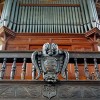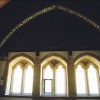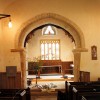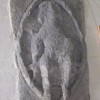Perhaps it could almost be said that Dorset was made for sheep and shepherding. Indeed, a flock of these animals in a pasture appears at the top of the county council’s website homepage and four hundred years ago there would certainly have been more sheep than people in the county. Of course, from the time of the shepherds watching over their flocks on the night of Jesus’ birth to the updated methods of the present day, sheep have always needed a labourer class to manage them; to pen, breed, feed and shear them. In short, the shepherds job.
Of course, sheep and shepherds are not exclusive to Dorset, though “hill farmer” is the term generally applied to the shepherd up north. For the Dorset shepherd the bedrock for his animals and livelihood has always meant the Dorset Heights, the great tract of Chalk downland spreading through the west and north of the county that has given rise to a native breed of sheep. Today though, the sheep population is but a shadow of what it would have been 400 to 500 years ago, when the implosion of the human population caused by the Black Death created such a shortage of labour for arable farming that it was more economic for landlords to enclose their land for pasture and keep sheep instead. So was laid the foundation of the great woollen industry that lasted until the 19th century.
The earliest reference to shepherds in the county may be attributed to Augustine who, tradition has it, once visited Dorset perhaps early in the 7th century and asked some shepherds tending their flocks in a field whether they preferred drinking beer or water. When the abstemious shepherds replied “water” Augustine is supposed to have struck the ground with his staff crying out “Cerne El” whereupon water gushed forth. The historian William of Malmsbury records that after St Aldhelm had died “Dorset shepherds, from neighbouring pastures” used to use a timber church or oratory the Bishop had built, as a shelter from rainstorms.
Hardy, in his extensive essay ‘The Dorset Labourer’ described the shepherd as “a lonely man of which the battle of life had always been sharp with him.” He is also described as being small frame, bowed over by hard work and who would stand at a hiring fair. His wages would not have exceeded eleven shillings a week. Hardy’s best-known fictional shepherd is probably Gabriel Oak, the ultimate beneficiary of the plot of ‘Far From the Madding Crowd.’ He is hired at a hiring-fair by the heroine Bathsheba Everdene and spends long hours out in the pasture tending her flock day and night. One night Oak shoots his sheepdog dead for stampeding the flock over a cliff while he is asleep, and in another instance cures the flock of “the blasting” after they stray into a field of clover. It is not certain whether the inspiration for these scenarios came from incidents in real life that the author may have witnessed or heard about.
Typically the 18th and 19th century shepherds would have worn smock-frocks and gaiters, though those young or of middle age sometimes wore smocks of a blue material. Only occasionally would they have worn cord trousers. Then there is the standard tool for the job: the crook. These are still made today, lightweight and durable accessories usually with hooks of buffalo horn fitted to shanks made from hazel or blackthorn.
Shepherds have also traditionally lived in purpose-built huts – almost windowless wooden caravan-like cabins on wheels measuring about 8 by 10 feet that could be towed onto the pasture where they would be working in the lambing season. They would have, as Hardy put it “sheltered the shepherd in his enforced nightly attendance.” Shepherd hut-making is a specialist craft that happily has been kept alive mainly through the excellent work of Richard Lee and Jane Dennison, two former students of John Makepeace at Hooke Collage, the school of woodcrafts at Parnham Manor near Beaminster.
At their Plankbridge workshop Richard and Jane use high quality materials locally sourced. Douglas fir is used for the frame and chassis, and the huts are fully insulated with versatile additional space; they can be used for the garden, orchard or filed. Features such as desks, cupboards, beds, heating and wiring may further be added. Te huts are finished off with an exterior coat of green paint and a set of steps for the door at the end are also provided.
One example of a modern Dorset shepherd of the 20th century is Larry Skeats. During a lifetime of shepherding extending across 45 years he folded the flocks in his care over the chalk downland using only dogs and wattle hurdles. At work his home became a shepherd’s hut. His autobiography ‘A Shepherds Delight: Memories of a Downland Shepherd,’ is a celebration of a bygone way of life by one of the last of the traditional shepherds.
Similarly, Ted Riglar began work aged twelve in 1901 as a shepherd at East Farm, Bincombe. Just two years later he sheared his first sheep, then went on to win a first prize of £4 at a shearing competition during a Bath & West Show in Dorchester in 1908. He then went on to acquire his Instructor’s Certificate in 1918. Born in 1891 Ernest Lovell was another ‘shep’ who started at age thirteen and by the mid 20th century was tending a four-hundred strong Dorset Horn flock at South Farm, Spetisbury. Lovell also bred sheep specialising in breeding rams and for this work won ten prizes at agricultural shows.
On occasion shepherds formerly may have delegated the responsibility of tending a flock to a hireling. Many shepherds would have smoked clay pipes and piped out folk tunes on a long-blown flute to keep themselves occupied throughout their long uneventful hours in the pasture. Early in the 20th century sheep used to be sheared at Upwey, where shearers at work were photographed in 1909. The prevalence of pastureland in Dorset is attested to in place-names such as Shepherd’s Bottom on the Ashmore Estate, and the shepherd is immortalised in a statue now standing in Dorchester.



